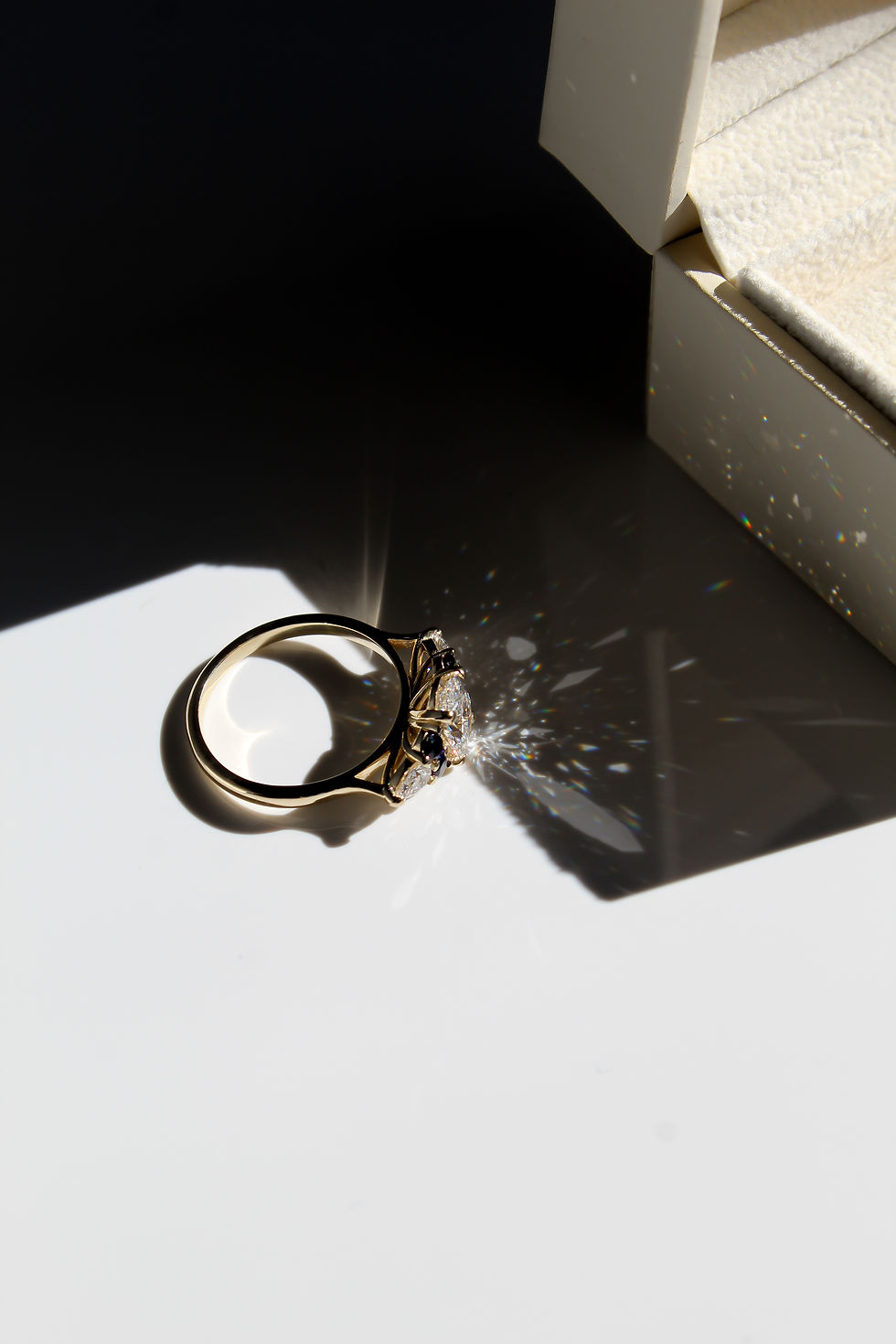Are You Buying Real Solid Gold—or Just “Gold” in the Title?
- Emily-Kate Turner
- Aug 6
- 7 min read
As a jeweller, I often hear from customers who thought they were buying solid gold in the past, only to later find out the piece was plated, vermeil, or simply “gold tone.” With so many products using “gold” in their titles, it’s easy to be misled. This guide will help you understand what you’re really buying, why solid gold is worth the investment, and how to avoid disappointment when shopping for jewellery online or in-store. So, are you buying real solid gold—or just “gold” in the title?
Why Solid Gold Matters
Solid gold jewellery stands the test of time. Unlike plated alternatives, solid gold won’t peel, tarnish, or lose its colour because it’s gold all the way through. Even lower-carat solid gold retains intrinsic metal value and will last for generations with basic care. It’s also hypoallergenic for most people, making it far kinder to the skin than base metals hidden under a plating layer.
When you choose solid gold, you’re not only investing in something beautiful, you’re choosing a piece that can be loved and worn for decades to come.
The Law: What Counts as “Gold” in the UK
In the UK, the description of precious metals is strictly regulated under the Hallmarking Act 1973 (amended 2009).
Here’s what you need to know:
Gold pieces over 1 gram must be independently assayed and hallmarked to confirm their purity.
Silver over 7.78 g, platinum over 0.5 g, and palladium over 1 g must also be hallmarked.
It is illegal to describe or sell something as gold, silver, platinum, or palladium without a hallmark if it meets the legal weight threshold.
Retailers must also display the official Dealer’s Notice about hallmarking both in-store and online.
This protects you as a buyer and ensures that when something is described as gold, it really is.
Plated, Vermeil, Waterproof vs. Solid Gold
There’s absolutely nothing wrong with plated, vermeil, or waterproof jewellery - as long as you know what you’re buying and what to expect from it. These pieces can be beautiful, affordable, and perfect for enjoying current trends. However, they are not the same as solid gold and won’t last forever in the same way.
Gold-plated jewellery has only a very thin layer of gold over a base metal (like brass or copper). This layer eventually wears off, especially with daily wear, exposing the base metal underneath which may tarnish or irritate the skin.
Gold vermeil uses a thicker layer of gold plating over a sterling silver base, making it more durable than standard plating. However, it is still a coating and will wear away over time, revealing the silver beneath. Some people enjoy this, but it does change the appearance of the piece.
“Waterproof” or “gold tone” jewellery usually contains no real gold at all. It is typically stainless steel or another base metal with a gold-coloured finish. While these pieces are often inexpensive and resistant to water damage, they don’t have the intrinsic value or warmth of genuine gold.
The key is honesty. There’s nothing wrong with choosing these alternatives when they’re described clearly, but issues arise when titles simply say “gold” without explaining what that means. Many customers end up disappointed when they realise what they purchased isn’t what they expected.
Solid gold is gold through and through. It doesn’t have a surface layer that can wear away, and it retains its beauty indefinitely. That’s why investing in solid gold from a trusted, transparent source, like JUNI, makes such a difference.
Understanding Solid Gold
Solid gold jewellery is made from an alloy of gold mixed with other metals for strength. It’s available in various carats - 9ct (375), 14ct (585), 18ct (750) - each containing a different proportion of pure gold. The hallmark confirms the exact purity and also shows the maker’s mark and assay office stamp.
At JUNI, every piece over the legal weight is independently hallmarked at an official UK Assay Office, guaranteeing authenticity and compliance.
What About White Gold vs. Yellow Gold?
Yellow gold Yellow gold is what most people picture when they think of gold - rich, warm, and timeless. Its colour comes naturally from the pure gold content mixed with small amounts of other metals to make it durable. In jewellery, you’ll see different carats such as 9ct, 14ct, and 18ct, with higher carat golds having a deeper, richer tone because they contain more pure gold. Whether it’s 9ct, 14ct, or 18ct, yellow gold is always a solid gold alloy - meaning the gold runs throughout the entire piece, not just on the surface.
White gold is often misunderstood. Some people believe it’s “plated” because of its pale colour, but this is not the case. White gold is also a solid gold alloy, created by blending pure gold with white metals like palladium or nickel to give it a naturally lighter tone. Unlike plated jewellery, which has only a thin layer of gold over a base metal, white gold is gold through and through.
The Truth About Rhodium Plating
Many high street jewellers rhodium-plate their white gold pieces to make them appear very bright and almost “ice white.” While this can be visually striking, rhodium is only a surface coating and wears away with time, requiring regular replating to keep up the look.
At JUNI, I prefer to leave my white gold unplated, allowing its natural colour to shine. The unplated tones of white gold have a subtle greyish warmth that many people fall in love with. Best of all, because it’s solid gold, you’re wearing the real metal - no upkeep or layers to worry about.
The key takeaway is this: both yellow and white gold are solid precious metals, with the gold content running throughout the piece, making them lasting investments that age beautifully.
Myth vs. Fact
Myth: White gold is plated.
Fact: White gold is a solid gold alloy. It is sometimes rhodium-plated, but the metal underneath is solid gold.
Myth: “Gold” in the product title means it’s solid gold.
Fact: It could be plated, vermeil, or simply gold-coloured unless clearly stated otherwise and hallmarked.
Myth: Plated jewellery is bad.
Fact: Plated jewellery can be lovely and affordable - it just won’t last like solid gold.
Myth: All gold jewellery is the same.
Fact: The quality varies hugely. Solid gold is gold through and through, whereas plated or vermeil jewellery only has a thin surface layer that eventually wears away.
Myth: If jewellery is expensive, it must be solid gold.
Fact: Price isn’t always an indicator of quality. Some plated pieces are marked up because of branding, not the intrinsic value of the metal.
Myth: You can’t tell if gold is real without specialist tools.
Fact: While professional testing is most accurate, a genuine UK hallmark on jewellery over the legal weight gives you an instant, reliable answer.
Myth: Sterling silver is “cheap” compared to gold.
Fact: Sterling silver is a precious metal in its own right, hallmarked and valued for its beauty. It’s a wonderful choice for fine jewellery.
Myth: White gold is the same as platinum.
Fact: They’re different metals. White gold is a gold alloy, while platinum is naturally white, denser, and often more expensive. Both are excellent choices, but they’re not interchangeable.
Myth: Waterproof jewellery means it’s solid gold.
Fact: “Waterproof” usually refers to a coating on a base metal, not the actual composition. Solid gold doesn’t need to claim it’s waterproof - it naturally resists tarnishing and corrosion.
Myth: Hallmarking is optional.
Fact: In the UK, it’s a legal requirement for all precious metal jewellery over a certain weight. Any reputable jeweller will comply with this law.
Why Choose JUNI?
Hallmarked Solid Materials Only
When you buy a piece from JUNI, you can feel completely confident that it is made from genuine solid materials - whether that’s gold, sterling silver, or platinum. Any item over the legal weight limit is independently hallmarked at an official UK Assay Office, so you know exactly what you’re getting. There’s no guesswork or hidden surprises; the hallmarks are your assurance that the metal purity is exactly as described. This is something I’m very passionate about because it protects you as the buyer and celebrates the beauty of true precious metals.
Complete Transparency
I believe jewellery buying should be clear and stress‑free, so I make sure to list every detail honestly. On my website, you’ll see the carat or purity stated clearly - such as “9ct yellow gold” - so there’s no confusion. I never use vague descriptions like “gold tone” or “gold finish” because they’re misleading. You deserve to know what you’re buying, and that’s why I’m always upfront about the materials I use. I want you to have that peace of mind when you invest in a piece you’ll wear and love for years.
Supporting an Independent Business
When you choose JUNI, you’re not only buying a beautiful piece of jewellery - you’re supporting a small, independent designer who pours her heart into every creation. Unlike mass‑produced products, each piece is thoughtfully designed and made with care. It means the world to me to know that my customers value this personal approach, and in return, I work hard to make sure every experience feels special. Your purchase doesn’t just support my business; it helps keep traditional skills alive and gives you a piece that truly has a story behind it.
Low‑Maintenance White Gold
One thing that makes JUNI a little different is my approach to white gold. Many high street jewellers rhodium‑plate white gold to give it a bright, almost chrome‑like finish. While it looks striking at first, it does wear off over time and needs regular replating - something that can be both costly and inconvenient. I personally love the natural colour of white gold in all its carats. It has a softer, more elegant tone that doesn’t require constant upkeep, and I choose to showcase that natural beauty rather than cover it up. It’s jewellery you can enjoy exactly as it is, without the worry of it losing its look.
How To Be a Smart Buyer
Look for hallmark stamps (maker’s mark, fineness, assay office) on pieces over the legal weight.
Ask the seller exactly what the piece is made from and whether it’s hallmarked.
Be cautious of vague product titles - if it only says “gold” without specifying carat or hallmark, it’s likely not solid gold.
Choose independent makers who provide transparent details about their materials.
Final Thoughts - Are you buying real solid gold, or just “gold” in the title?
Solid gold jewellery is an investment in enduring beauty. While plated, vermeil, and other alternatives have their place, they simply don’t compare to the lasting value of solid precious metals.
At JUNI, every piece is made from solid gold, sterling silver, or platinum- always hallmarked where required, and always described honestly. When you choose JUNI, you’re choosing transparency, quality, and a piece you can love for years to come.
Explore my hallmarked solid gold and platinum collections here and invest in jewellery that’s made to last.
Forveer & Always, Love
Emily x































Such a interesting and eye opening read. Thank you for this! I have been caught out before where a company advised it as gold but it was plated silver.